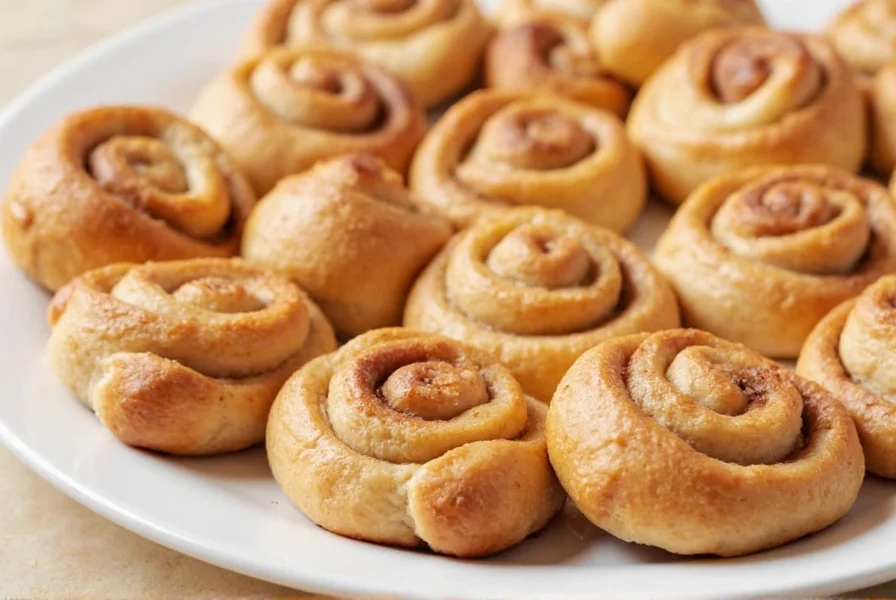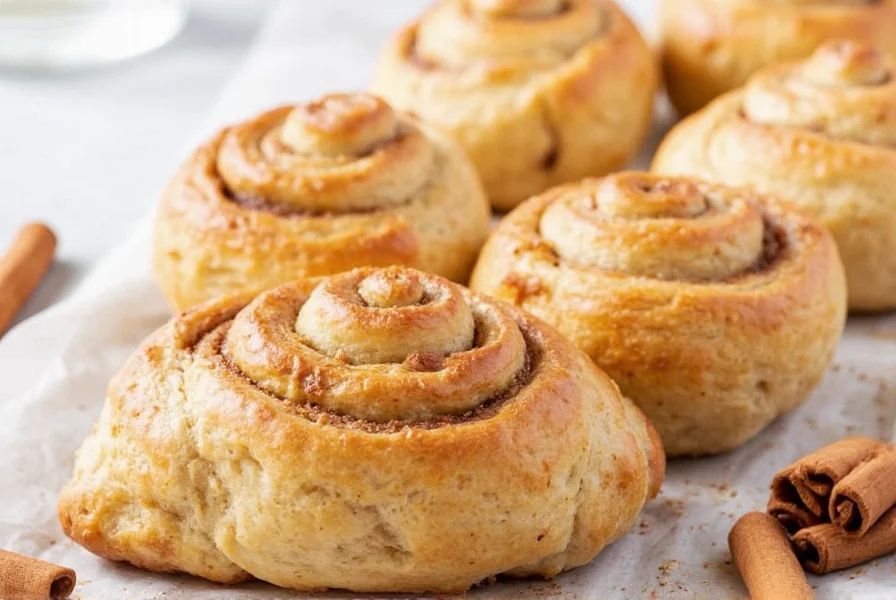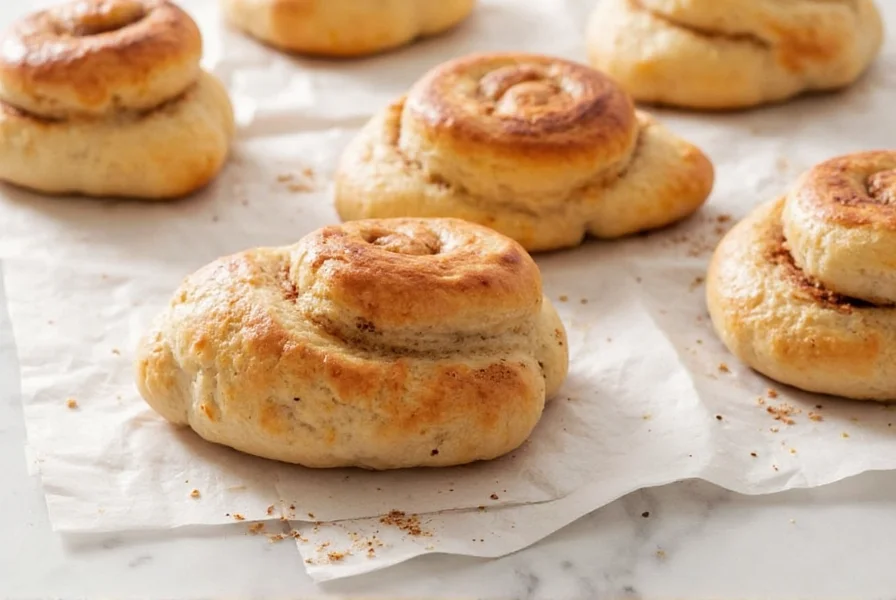The Science Behind Yeast in Cinnamon Scrolls
Yeast transforms simple dough into ethereal cinnamon scrolls through biological alchemy. Unlike chemical leaveners, Saccharomyces cerevisiae (baker's yeast) consumes sugars and produces carbon dioxide and alcohol through fermentation. This biological process creates thousands of tiny air pockets that give yeast-raised scrolls their signature light texture. The secondary benefit? Flavor development. As yeast works, it produces organic compounds that create subtle tangy notes, balancing the sweetness of the filling. This complex flavor profile distinguishes authentic yeast cinnamon scrolls from quicker baking powder versions.
Yeast Selection and Activation Guide
Choosing the right yeast makes or breaks your cinnamon scroll texture. Here's how to select and activate properly:
| Yeast Type | Activation Method | Best For | Rising Time |
|---|---|---|---|
| Active Dry Yeast | Bloom in warm liquid (105-110°F) with pinch of sugar | Traditional recipes, beginners | 1.5-2 hours |
| Instant Yeast | Mix directly with dry ingredients | Experienced bakers, time-sensitive | 1-1.5 hours |
| Fresh Yeast | Crumble into warm liquid | Artisan results, professional kitchens | 1.5-2 hours |
Always test yeast viability before making homemade yeast cinnamon scrolls recipe batches. Combine 1/4 teaspoon sugar with 1/4 cup lukewarm liquid (milk or water) and your yeast. After 10 minutes, it should foam to double its volume. No foam means replace your yeast.

Perfect Yeast Cinnamon Scroll Recipe
This tested recipe produces bakery-quality results with proper yeast development:
Dough Ingredients
- 3 1/2 cups all-purpose flour
- 2 1/4 teaspoons active dry yeast
- 1/3 cup granulated sugar
- 1/2 teaspoon salt
- 1 cup warm milk (105-110°F)
- 1/3 cup unsalted butter, melted
- 1 large egg
Cinnamon Filling
- 1/2 cup packed brown sugar
- 2 tablespoons ground cinnamon
- 1/4 cup unsalted butter, softened
Glaze
- 4 oz cream cheese, softened
- 1/4 cup unsalted butter, softened
- 1 cup powdered sugar
- 1/2 teaspoon vanilla extract
- 1-2 tablespoons milk
Step-by-Step Baking Process
- Mix dough: Combine yeast with warm milk and sugar. Wait 10 minutes until foamy. Mix with flour, salt, melted butter, and egg until smooth.
- First rise: Knead 5-7 minutes until elastic. Place in greased bowl, cover, and rise at room temperature until doubled (60-90 minutes).
- Roll and fill: Roll dough into 16x12 inch rectangle. Spread softened butter, then cinnamon-sugar mixture evenly.
- Shape scrolls: Roll tightly from long side, pinch seam. Cut into 12 equal pieces using dental floss for clean cuts.
- Second rise: Place in greased pan, cover, rise 30-45 minutes until puffy.
- Bake: 350°F for 20-25 minutes until golden brown.
- Glaze: Mix ingredients until smooth, drizzle over warm scrolls.
Troubleshooting Common Yeast Scroll Problems
Even experienced bakers encounter issues with yeast cinnamon roll dough. Here's how to fix them:
- Dense texture: Over-flouring or under-proofing causes this. Measure flour by spooning into cup (don't scoop), and allow full rising time. The dough should spring back slowly when gently pressed.
- Collapsed scrolls: Over-proofing makes dough unstable. Watch for visual cues (doubled size) rather than strict timing. Ideal proofing environment is 75-80°F with moderate humidity.
- Leaking filling: Too much butter in filling causes this. Use softened (not melted) butter and spread evenly without overloading edges.
- Yeast flavor too strong: This indicates over-fermentation. Reduce rising time by 15-20 minutes or lower room temperature during proofing.

Advanced Techniques for Exceptional Results
Elevate your best yeast for cinnamon scrolls experience with these professional methods:
- Cold fermentation: Refrigerate shaped rolls overnight. The slow rise develops deeper flavor and creates more defined layers.
- Yogurt addition: Replace 1/4 cup milk with plain yogurt for enhanced tenderness and subtle tang that complements cinnamon.
- Double rise technique: After first rise, punch down dough, shape, then let rise again before cutting. Creates more uniform texture.
- Steam injection: Place water-filled pan on oven floor during baking for professional-level oven spring.
Storage and Reheating Guidelines
Yeast-based cinnamon scrolls maintain quality differently than chemical-leavened versions:
- Freshness timeline: Consume within 24 hours for optimal texture. Yeast scrolls stale faster than baking powder versions due to higher moisture content.
- Room temperature storage: Keep in airtight container with paper towel to absorb excess moisture (max 2 days).
- Freezing method: Freeze unglazed rolls on baking sheet, then transfer to freezer bags. Bake from frozen, adding 5-7 minutes to baking time.
- Reheating secret: Microwave 10 seconds followed by 2 minutes in 300°F oven restores near-fresh texture without drying out.
Frequently Asked Questions
Can I substitute instant yeast for active dry yeast in cinnamon scrolls?
Yes, use the same quantity but skip the blooming step. Mix instant yeast directly with dry ingredients. You'll reduce rising time by 15-20% since instant yeast activates faster. This works well for time-sensitive quick yeast cinnamon scroll preparation without sacrificing quality.
Why did my yeast cinnamon scrolls collapse after baking?
Collapse typically indicates over-proofing. Yeast produces gas until the dough structure can't contain it. For reliable yeast cinnamon roll troubleshooting, watch for visual cues: properly proofed dough should spring back slowly when gently pressed. Ideal proofing environment is 75-80°F with moderate humidity. Avoid letting rolls rise until they look puffy and jiggle.
How do I prevent cinnamon filling from leaking during baking?
Leaking filling occurs when butter is too liquid. Use softened (not melted) butter for the filling and spread evenly without overloading the edges. Leave a 1/2 inch border clean around the rectangle's edges. For foolproof cinnamon scroll filling techniques, chill the rolled dough for 15 minutes before cutting to solidify the butter.
Can I make yeast cinnamon scrolls without dairy?
Absolutely. Substitute plant-based milk (soy or oat work best) for dairy milk, and use coconut oil or vegan butter. For the glaze, replace cream cheese with cashew cream (soaked cashews blended with lemon juice). This dairy-free adaptation maintains the essential yeast-raised cinnamon scroll texture while accommodating dietary restrictions.
What's the ideal temperature for yeast proofing cinnamon scroll dough?
The optimal temperature range for yeast activity in cinnamon scroll dough preparation is 75-80°F (24-27°C). Below 70°F, yeast becomes sluggish; above 85°F, it works too quickly, compromising flavor development. Create a proofing environment by placing dough in oven with light on (no heat) or near a warm appliance. Use a thermometer to verify temperature for consistent results.











 浙公网安备
33010002000092号
浙公网安备
33010002000092号 浙B2-20120091-4
浙B2-20120091-4